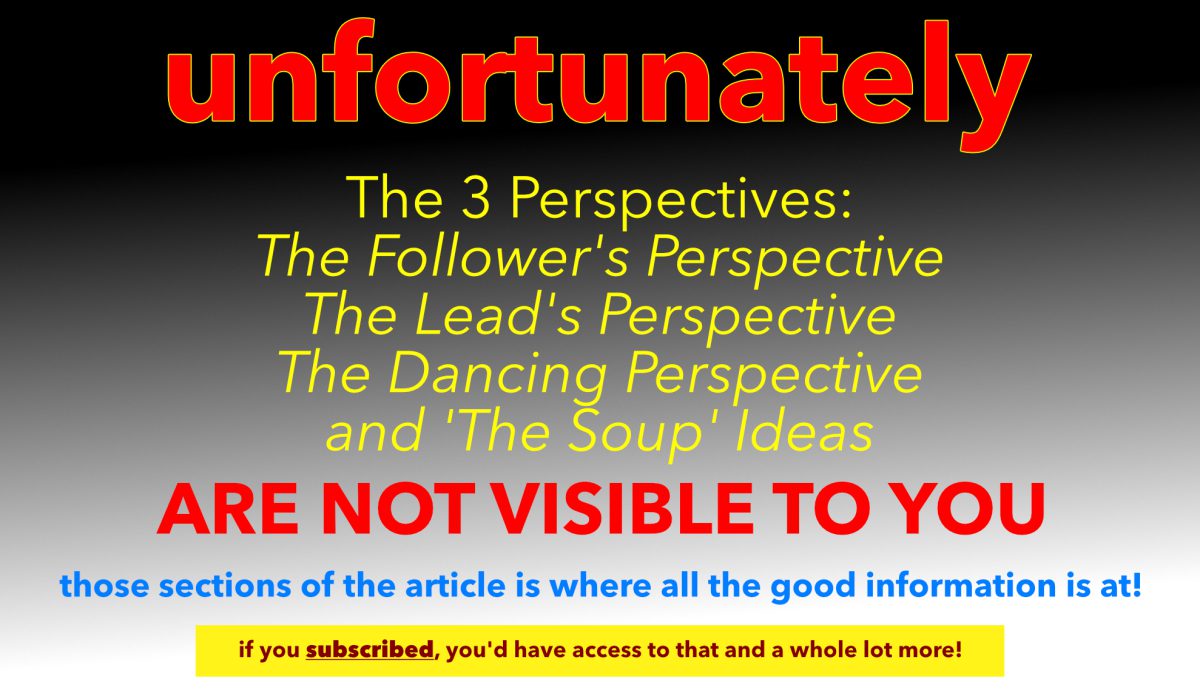The word Boleo comes the root Spanish word “Bolear” which roughly translates into English as “To Shine” or “To Throw”. The word ‘Boleo‘ is pronounced: “Boh-Lay-Oh” with the emphasis on the 2nd syllable. Boleo is the first person singular, meaning “I throw” or”I shine”. That’s about where the English and the Spanish meanings stop and take in a completely different meaning from a Tango perspective. From a Tango perspective we view this as a very specific piece of Tango Vocabulary which is nothing short of gob-stopping when executed properly, and in time to the music. Typically for most people when they hear the word Boleo they can only conceive of one type of Boleo, and that’s the flashy, but respectable, High Circular Boleo variety. To be clear, a Boleo, in its simplest definition, is one the four Tango Displacements, (Gancho, Wrap or Enganche, and Sacada being the other 3) that Tango Topics talks about. In the case of the Boleo, the Follower is led to “Throw” their leg behind them in any number of ways. However, that descriptive is a little misleading because the “throw” that is implied isn’t a ‘throw’, it’s a very controlled and contained action that shouldn’t be trifled with. Secondly, there’s a very specific reason why the Boleo occurs, which almost never get’s talked about or shown. There are lots and lots and lots of Boleo videos on YouTube for you to go watch. However, not one of them, not a single one, explains HOW you safely generate one, why a Boleo occurs, and more importantly the necessary skillsets that are required before you can or should attempt to even in engage in one. This video series does. Today’s Tango Topic looks at that set of circumstances and creates a very specific type of Boleo that could easily be called a “Low” Boleo but it is more apt to be called a Social Boleo. So without further adieu or yapping, Tango Topics presents The Social Boleo and Social Contra Boleo.
What is a Social Boleo ? We must make clear the first part of the Term “Social” of “Social Boleo”. Social in this context that Tango Topics typically defines that word as: 1.) The Ronda of the dance floor, pertaining to the line, lane, and Tango Floorcraft of the couple. 2.) The Milonga experience. Meaning how you enter the room, who you speak to, where you sit, how you sit, what you dance to, who you dance with, how you invite or deny a dance. 3.) Fitting any and all vocabulary choices, regardless of which role is initiating it, within the physical width of the “lane” of dance, and the physical distance of one singular step that goes with the line of dance.
The definition for a Boleo is as above, but in this context it would be where the Follower (or the Lead) is led (or self-led in the case of the Lead) to extend and then to lift their leg (that’s the throw part from above) behind them in a very controlled and contained fashion that can in certain cases be linear (in or on a line), or circular. Low (sometimes referred to as a ‘Social Boleo’), mid-range, or high (the common one). Quick, languid, and/or frozen. Which are either done “With” the Follower’s motion, or against the Follower’s motion (which would make it a ‘Contra’ Boleo).
Therefore a Social Boleo is a type of low(emphasis on the ‘low‘ part), circular, ‘With’ type Boleo that can be done quickly or languidly and can also have a frozen component. In this highly specific type of Boleo, the dancer’s foot would never, ever, leave the floor. Typically in High Boleos, the dancer’s foot would come off the floor. In this instance, because these are Social Boleos, the dancer’s foot stays on the floor, and extends in a circular fashion!
Typically the Social Boleo is ideal for Dancing In A Small Space, the Encuentro Environment, Dancing in confined spaces, and/or certain Milongas in Buenos Aires, like Salon Canning, El Beso, or Cachirulo, and most certainly the quiet, but well attended, Barrio Milongas. The Social Boleo is an easeful, and really, the easiest of Boleos to learn, and then to start dancing, from a Leading and Following perspective. And that’s because, for the most part, you’re already doing them without realizing that you’re doing them!

About The Video. This video is 37m:34s in length in 15 sections. Both lead and follower vocabulary are combined and integrated into the video.
Introduction – 00:01:22
How to Start The Social Boleo – 00:01:05
The Follower’s Ocho – 00:03:09
Follower’s Specifics for Back Steps – 00:00:49
The Follower Stepping Away – 00:00:47
Leading & Following The Social Boleo – 00:01:54
The Engine of the Social Boleo – 00:04:33
Creating The Size of the Boleo – 00:01:24
The Open Embrace Version – 00:01:19
— in Slow Motion – 00:01:13
The Close Embrace Version (and in slow motion) – 00:04:30
The ‘Rebote’ Idea – 00:01:39
The Social Contra Boleo – 00:03:09
A Social Boleo with A Social Contra Boleo – 00:02:56
Final Thoughts/Closure Items – 00:06:32

